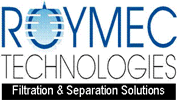As background, Skorpion Zinc has not been able to reduce the PLS suspended solids to the stringent specification levels required for zinc solvent extraction.
The mine has trialed numerous clarification technologies since start up, including sand filters, conventional large diameter clarifiers, floating media filters, without success. During extensive PBC trials that were run and supported by Anglo American Research using Roymec’s pilot PBC unit, feed to the unit ran at between 50–250ppm.
Dr Kathy Sole, anglo research project manager for this pilot trials said, “The tests demonstrated conclusively that the Roymec pilot PBC could successfully maintain the PLS suspended solids to within the required design specifications.”
The trials presented Roymec the opportunity to look in depth at the feed conditioning and chemical dosing process and optimise reagent usage and flocculation, so much so that they were able to reduce overall chemical consumption and achieve improved final overflow results on a sustainable basis.
Similar PLS clarification trials have since been conducted by Roymec at the Kanshanshi Copper and Chambishi Copper and Cobalt plants on the Zambian copper belt, and results indicate similar trends.
Jacques continued, “The PLS clarification project encompassed the supply, delivery to site and installation from South Africa to Namibia of a reagent dosing circuit, feed splitter, three pin bed clarifier structures, elevated platforms and elevated tank support structures. The PLS clarification plant treats approx 1000m3/hr in three PBC’s in parallel. The units are steep cone clarifiers, having deep sidewalls and are constructed from carbon steel with polyurethane internal lining. The top of the tank is approximately 18m from ground level.”
Jacques said, “Rosh Pinah is relatively remote and an expensive site to establish cranage and equipment. Skorpion Zinc had maintenance cranes which could be made intermittently available for construction purposes but not over continuous periods. The new PLS clarification plant will process large quantities of the acidic PLS electrolyte which is extremely aggressive towards mild steel and will displace an existing sand filter installation.
This meant that the new plant had to be placed as close as possible to the redundant filter installation to allow the reuse of existing pumps and plant infrastructure. In addition, the new plant had to be installed inside existing, working plant without severely interrupting the existing operations, which key to the overall success of the new project. We did not want any plant downtime and loss of production.
Jacques went on to say that Roymec performed well in terms of project deliverables in this regard.
Traditionally, large tanks in PLS service are fabricated either in resistant stainless steels or lined concrete. Skorpion has extensive experience and skills with lined mild steel systems in acid service and was comfortable with building a mild steel tank with impact and working surfaces fabricated in 904s/s. After weld completion, the inside of the tanks were blasted and coated with a polyurethane lining system.
The final erection procedure entailed fabrication, welding and partial painting of the cone and shell in South Africa, completing every longitudinal shell weld in South Africa. All portions were fabricated at less than 4.8 m transport height and the complex wedge wire screen portion of the shell was installed and welded in South Africa at ground level.
Shell sections were flanged so that the flange acted as a transport and lifting stiffener and boilermaking alignment tool. After installation, the flanged joint was seal or strength welded as required, with little or no external coating repair.
“It was estimated that the use of South African fabrication and maximizing the use of abnormal transport loads reduced the size of the construction crew on site and the duration of the period on site by approximately 8 weeks and contributed towards the financial viability of the project,” commented Jacques.

